New Schiff Base–TMB Hybrids: Design, Synthesis and Antiproliferative Investigation as Potential Anticancer Agents
Abstract
:1. Introduction
2. Results and Discussion
2.1. Chemistry
2.2. Biology
2.2.1. Cytotoxic Activity against the MCF-7 Breast Cancer Cell Line
2.2.2. β-Tubulin Polymerization Inhibition Assay
2.2.3. Cell Cycle Analysis
2.2.4. Apoptosis Staining Assay
2.2.5. Quantitative Real-Time PCR: MCF-7 Breast Cancer Cells Express mRNA for Human p53, Bax, and Bcl-2
2.3. Molecular Docking Study
3. Conclusions
4. Experimental
4.1. Chemistry
4.1.1. General
4.1.2. General Method for the Synthesis of (Z)-N-(1-(4-(Dimethylamino)phenyl)-3-hydrazinyl-3-oxoprop-1-en-2-yl)-3,4,5-trimethoxybenzamide (2)
4.1.3. General Procedure for the Synthesis of Schiff Bases 3 and 4a–i
N-((Z)-1-(4-(Dimethylamino)phenyl)-3-((E)-2-(furan-2-ylmethylene)hydrazinyl)-3-oxoprop-1-en-2-yl)-3,4,5-trimethoxybenzamide (3)
N-((Z)-1-(4-(Dimethylamino)phenyl)-3-((E)-2-(2-hydroxybenzylidene)hydrazinyl)-3-oxoprop-1-en-2-yl)-3,4,5-trimethoxybenzamide (4a)
N-((Z)-1-(4-(Dimethylamino)phenyl)-3-((E)-2-(4-hydroxybenzylidene)hydrazinyl)-3-oxoprop-1-en-2-yl)-3,4,5-trimethoxybenzamide (4b)
N-((Z)-3-((E)-2-(4-(Dimethylamino)benzylidene)hydrazinyl)-1-(4-(dimethylamino)phenyl)-3-oxoprop-1-en-2-yl)-3,4,5-trimethoxybenzamide (4c)
N-((Z)-1-(4-(Dimethylamino)phenyl)-3-((E)-2-(4-methylbenzylidene)hydrazinyl)-3-oxoprop-1-en-2-yl)-3,4,5-trimethoxybenzamide (4d)
N-((Z)-1-(4-(Dimethylamino)phenyl)-3-((E)-2-(4-methoxybenzylidene)hydrazinyl)-3-oxoprop-1-en-2-yl)-3,4,5-trimethoxybenzamide (4e)
N-((Z)-1-(4-(Dimethylamino)phenyl)-3-((E)-2-(2-hydroxy-3-methoxybenzylidene)hydrazinyl)-3-oxoprop-1-en-2-yl)-3,4,5-trimethoxybenzamide (4f)
N-((Z)-1-(4-(Dimethylamino)phenyl)-3-((E)-2-(4-hydroxy-3-methoxybenzylidene)hydrazinyl)-3-oxoprop-1-en-2-yl)-3,4,5-trimethoxybenzamide (4g)
N-((Z)-3-((E)-2-(3,5-Dimethoxybenzylidene)hydrazinyl)-1-(4-(dimethylamino)phenyl)-3-oxoprop-1-en-2-yl)-3,4,5-trimethoxybenzamide (4h)
N-((Z)-1-(4-(Dimethylamino)phenyl)-3-oxo-3-((E)-2-(3,4,5-trimethoxybenzylidene)hydrazinyl)prop-1-en-2-yl)-3,4,5-trimethoxybenzamide (4i)
4.2. Biological Studies
4.2.1. MTT Cytotoxicity Assay
4.2.2. β-Tubulin Polymerization Assay
4.2.3. Cell Cycle Analysis
4.2.4. Annexin V/FITC Staining Assay
4.2.5. Effect on p53, Bax, and Bcl-2 Expression Levels
Supplementary Materials
Funding
Data Availability Statement
Conflicts of Interest
References
- Łukasiewicz, S.; Czeczelewski, M.; Forma, A.; Baj, J.; Sitarz, R.; Stanisławek, A. Breast Cancer—Epidemiology, Risk Factors, Classification, Prognostic Markers, and Current Treatment Strategies—An Updated Review. Cancers 2021, 13, 4287. [Google Scholar] [CrossRef] [PubMed]
- Forooshani, M.K.; Scarpitta, R.; Fanelli, G.; Miccoli, M.; Naccarato, A.; Scatena, C. Is it time to consider the Androgen receptor as a therapeutic target in breast cancer? Anti-Cancer Agents Med. Chem. 2022, 22, 775. [Google Scholar] [CrossRef] [PubMed]
- Mann, R.M.; Athanasiou, A.; Baltzer, P.; Camps-Herrero, J.; Clauser, P.; Fallenberg, E.; Forrai, G.; Fuchsjäger, M.; Helbich, T.; Killburn-Toppin, F.; et al. Breast cancer screening in women with extremely dense breasts recommendations of the European Society of Breast Imaging (EUSOBI). Eur. Radiol. 2022, 32, 4036. [Google Scholar] [CrossRef] [PubMed]
- Kumar-Sinha, C.; Chinnaiyan, A.M. Defining cancer growth beyond the mitotic index. Nat. Cell Biol. 2022, 24, 285. [Google Scholar] [CrossRef]
- Novais, P.; Silva, P.; Amorim, I.; Bousbaa, H. Second-generation antimitotics in cancer clinical trials. Pharmaceutics 2021, 13, 1011. [Google Scholar] [CrossRef]
- Shuai, W.; Wang, G.; Zhang, Y.; Bu, F.; Zhang, S.; Miller, D.; Li, W.; Ouyang, L.; Wang, Y. Recent Progress on Tubulin Inhibitors with Dual Targeting Capabilities for Cancer Therapy. J. Med. Chem. 2021, 64, 7963. [Google Scholar] [CrossRef]
- Ebenezer, O.; Shapi, M.; Tuszynski, J.A. A Review of the Recent Developments of Molecular Hybrids Targeting Tubulin Polymerization. Int. J. Mol. Sci. 2022, 23, 4001. [Google Scholar] [CrossRef]
- Jaunky, D.B.; Larocque, K.; Husser, M.; Liu, J.; Forgione, P.; Piekny, A. Characterization of a recently synthesized microtubule-targeting compound that disrupts mitotic spindle poles in human cells. Sci. Rep. 2021, 11, 23665. [Google Scholar] [CrossRef]
- Huang, L.; Peng, Y.; Tao, X.; Ding, X.; Li, R.; Jiang, Y.; Zuo, W. Microtubule Organization Is Essential for Maintaining Cellular Morphology and Function. Oxidative Med. Cell. Longev. 2022, 2022, 1623181. [Google Scholar] [CrossRef]
- Spiliotis, E.T.; Nakos, K. Cellular functions of actin- and microtubule-associated septins. Curr. Biol. 2021, 31, R651. [Google Scholar] [CrossRef]
- Khwaja, S.; Kumar, K.; Das, R.; Negi, A.S. Microtubule associated proteins as targets for anticancer drug development. Bioorg. Chem. 2021, 116, 105320. [Google Scholar] [CrossRef] [PubMed]
- Best, R.L.; LaPointe, N.; Azarenko, O.; Miller, H.; Genualdi, C.; Chih, S.; Shen, B.-Q.; Jordan, M.; Wilson, L.; Feinstein, S.; et al. Microtubule and tubulin binding and regulation of microtubule dynamics by the antibody drug conjugate (ADC) payload, monomethyl auristatin E (MMAE): Mechanistic insights into MMAE ADC peripheral neuropathy. Toxicol. Appl. Pharmacol. 2021, 421, 115534. [Google Scholar] [CrossRef]
- Romagnoli, R.; Oliva, P.; Salvador, M.; Manfredini, S.; Padroni, C.; Brancale, A.; Ferla, S.; Hamel, E.; Ronca, R.; Maccarinelli, F.; et al. A facile synthesis of diaryl pyrroles led to the discovery of potent colchicine site antimitotic agents. Eur. J. Med. Chem. 2021, 214, 113229. [Google Scholar] [CrossRef] [PubMed]
- Mousset, C.; Giraud, A.; Provot, O.; Hamze, A.; Bignon, J.; Liu, J.-M.; Thoret, S.; Dubois, J.; Brion, J.-D.; Alami, M. Synthesis and antitumor activity of benzils related to combretastatin A-4. Bioorg. Med. Chem. Lett. 2008, 18, 3266. [Google Scholar] [CrossRef] [PubMed] [Green Version]
- Zheng, J.; Deng, L.; Chen, M.; Xiao, X.; Xiao, S.; Guo, C.; Xiao, G.; Bai, L.; Ye, W.; Zhang, D.; et al. Elaboration of thorough simplified vinca alkaloids as antimitotic agents based on pharmacophore similarity. Eur. J. Med. Chem. 2013, 65, 158. [Google Scholar] [CrossRef]
- Piekuś-Słomka, N.; Mikstacka, R.; Ronowicz, J.; Sobiak, S. Hybrid cis-stilbene molecules: Novel anticancer agents. Int. J. Mol. Sci. 2019, 20, 1300. [Google Scholar] [CrossRef] [Green Version]
- Bukhari, S.N.A.; Zakaria, M.; Munir, M.; Ahmad, N.; Elsherif, M.; Badr, R.; Hassan, A.; Almaaty, A.; Zaki, I. Design, Synthesis, In Vitro Biological Activity Evaluation and Stabilized Nanostructured Lipid Carrier Formulation of Newly Synthesized Schiff Bases-Based TMP Moieties. Pharmaceuticals 2022, 15, 679. [Google Scholar] [CrossRef]
- McLoughlin, E.C.; O’Boyle, N.M. Colchicine-Binding Site Inhibitors from Chemistry to Clinic: A Review. Pharmaceuticals 2020, 13, 8. [Google Scholar] [CrossRef] [Green Version]
- Bertheloot, D.; Latz, E.; Franklin, B.S. Necroptosis, pyroptosis and apoptosis: An intricate game of cell death. Cell. Mol. Immunol. 2021, 18, 1106. [Google Scholar] [CrossRef]
- Azarbarzin, S.; Hosseinpour-Feizi, M.; Khojasteh, S.B.; Baradaran, B.; Safaralizadeh, R. MicroRNA-383-5p restrains the proliferation and migration of breast cancer cells and promotes apoptosis via inhibition of PD-L1. Life Sci. 2021, 267, 118939. [Google Scholar] [CrossRef]
- Zuo, Y.; Zhang, C.-Z.; Ren, Q.; Chen, Y.; Li, X.; Yang, J.-R.; Li, H.-X.; Tang, W.-T.; Ho, H.-M.; Sun, C.; et al. Activation of mitochondrial-associated apoptosis signaling pathway and inhibition of PI3K/Akt/mTOR signaling pathway by voacamine suppress breast cancer progression. Phytomedicine 2022, 99, 154015. [Google Scholar] [CrossRef] [PubMed]
- Placzek, W.J.; Wei, J.; Kitada, S.; Zhai, D.; Reed, J.; Pellecchia, M. A survey of the anti-apoptotic Bcl-2 subfamily expression in cancer types provides a platform to predict the efficacy of Bcl-2 antagonists in cancer therapy. Cell Death Dis. 2010, 1, e40. [Google Scholar] [CrossRef] [PubMed] [Green Version]
- Zaki, I.; Moustafa, A.; Beshay, B.; Masoud, R.; Elbastawesy, M.; Abourehab, M.; Zakaria, M.Y. Design and synthesis of new trimethoxylphenyl-linked combretastatin analogues loaded on diamond nanoparticles as a panel for ameliorated solubility and antiproliferative activity. J. Enzym. Inhib. Med. Chem. 2022, 37, 2679. [Google Scholar] [CrossRef] [PubMed]
- Zhang, Z.; Bai, L.; Hou, L.; Deng, H.; Luan, S.; Liu, D.; Huang, M.; Zhao, L. Trends in targeting Bcl-2 anti-apoptotic proteins for cancer treatment. Eur. J. Med. Chem. 2022, 232, 114184. [Google Scholar] [CrossRef] [PubMed]
- Al-Warhi, T.; Aldhahrani, A.; Althobaiti, F.; Fayad, E.; Ali, O.A.; Albogami, S.; Almaaty, A.A.; Khedr, A.; Bukhari, S.; Zaki, I. Design, Synthesis and Cytotoxic Activity Evaluation of Newly Synthesized Amides-Based TMP Moiety as Potential Anticancer Agents over HepG2 Cells. Molecules 2022, 27, 3960. [Google Scholar] [CrossRef]
- Tadele, K.T.; Tsega, T.W. Schiff Bases and their metal complexes as potential anticancer candidates: A review of recent works. Anti-Cancer Agents Med. Chem. 2019, 19, 1786. [Google Scholar] [CrossRef]
- Howsaui, H.B.; Basaleh, A.; Abdellattif, M.; Hassan, W.; Hussien, M.A. Synthesis, Structural Investigations, Molecular Docking, and Anticancer Activity of Some Novel Schiff Bases and Their Uranyl Complexes. Biomolecules 2021, 11, 1138. [Google Scholar] [CrossRef]
- Shekhar, S.; Khan, A.; Sharma, S.; Sharma, B.; Sarkar, A. Schiff base metallodrugs in antimicrobial and anticancer chemotherapy applications: A comprehensive review. Emergent Mater. 2022, 5, 279. [Google Scholar] [CrossRef]
- Uddin, N.; Rashid, F.; Ali, S.; Tirmizi, S.; Ahmad, I.; Zaib, S.; Zubair, M.; Diaconescu, P.; Tahir, M.; Iqbal, J.; et al. Synthesis, characterization, and anticancer activity of Schiff bases. J. Biomol. Struct. Dyn. 2020, 38, 3246. [Google Scholar] [CrossRef]
- Medarde, M.; Maya, A.; Pérez-Melero, C. Naphthalene Combretastatin Analogues: Synthesis, Cytotoxicity and Antitubulin Activity. J. Enzyme Inhib. Med. Chem. 2004, 19, 521. [Google Scholar] [CrossRef]
- Iacopetta, D.; Rosano, C.; Puoci, F.; Parisi, O.; Saturnino, C.; Caruso, A.; Longo, P.; Ceramella, J.; Malzert-Fréon, A.; Dallemagne, P.; et al. Multifaceted properties of 1,4-dimethylcarbazoles: Focus on trimethoxybenzamide and trimethoxyphenylurea derivatives as novel human topoisomerase II inhibitors. Eur. J. Pharm. Sci. 2017, 96, 263. [Google Scholar] [CrossRef] [PubMed]
- Piplani, P.; Sharma, M.; Mehta, P.; Malik, R. N-(4-Hydroxyphenyl)-3,4,5-trimethoxybenzamide derivatives as potential memory enhancers: Synthesis, biological evaluation and molecular simulation studies. J. Biomol. Struct. Dyn. 2018, 36, 1867. [Google Scholar] [CrossRef] [PubMed]
- Panno, A.; Sinicropi, M.; Caruso, A.; El-Kashef, H.; Lancelot, J.-C.; Aubert, G.; Lesnard, A.; Cresteil, T.; Rault, S. New Trimethoxybenzamides and Trimethoxyphenylureas Derived from Dimethylcarbazole as Cytotoxic Agents. Part I. J. Heterocycl. Chem. 2014, 51, E294. [Google Scholar] [CrossRef]
- Li, Q.; Jian, X.-E.; Chen, Z.-R.; Chen, L.; Huo, X.-S.; Li, Z.-H.; You, W.-W.; Rao, J.-J.; Zhao, P.-L. Synthesis and biological evaluation of benzofuran-based 3,4,5-trimethoxybenzamide derivatives as novel tubulin polymerization inhibitors. Bioorg. Chem. 2020, 102, 104076. [Google Scholar] [CrossRef]
- Jiménez, C.; Ellahioui, Y.; Álvarez, R.; Aramburu, L.; Riesco, A.; González, M.; Vicente, A.; Dahdouh, A.; Mansour, A.I.; Jiménez, C.; et al. Exploring the size adaptability of the B ring binding zone of the colchicine site of tubulin with para-nitrogen substituted isocombretastatins. Eur. J. Med. Chem. 2015, 100, 210. [Google Scholar] [CrossRef]
- Lara, R.; Millán, G.; Moreno, M.; Lalinde, E.; Alfaro-Arnedo, E.; López, I.; Larráyoz, I.; Pichel, J.G. Investigation on Optical and Biological Properties of 2-(4-Dimethylaminophenyl)benzothiazole Based Cycloplatinated Complexes. Chem. Eur. J. 2021, 27, 15757. [Google Scholar] [CrossRef]
- Zaki, I.; Masoud, R.; Hamoud, M.; Ali, O.; Abualnaja, M.; Fayad, E.; Almaaty, A.; Elnaghia, L.K. Design, synthesis and cytotoxicity screening of new synthesized pyrimidine-5-carbonitrile derivatives showing marked apoptotic effect. J. Mol. Struct. 2022, 1259, 132749. [Google Scholar] [CrossRef]
- Al-Warhi, T.; Abualnaja, M.; Ali, O.A.; Althobaiti, F.; Alharthi, F.; Elsaid, F.; Shati, A.; Fayad, E.; Elghareeb, D.; Almaaty, A.A.; et al. Synthesis and Biological Activity Screening of Newly Synthesized Trimethoxyphenyl-Based Analogues as Potential Anticancer Agents. Molecules 2022, 27, 4621. [Google Scholar] [CrossRef]
- Al-Warhi, T.; Alqahtani, L.; Abualnaja, M.; Beigh, S.; Ali, O.A.; Elsaid, F.; Shati, A.; Saleem, R.; Maghrabi, A.; Alharthi, A.; et al. Design, Synthesis, and In Vitro Antiproliferative Screening of New Hydrazone Derivatives Containing cis-(4-Chlorostyryl) Amide Moiety. Symmetry 2022, 14, 2457. [Google Scholar] [CrossRef]
- Boichuk, S.; Galembikova, A.; Syuzov, K.; Dunaev, P.; Bikinieva, F.; Aukhadieva, A.; Zykova, S.; Igidov, N.; Gankova, K.; Novikova, M.; et al. The Design, Synthesis, and Biological Activities of Pyrrole-Based Carboxamides: The Novel Tubulin Inhibitors Targeting the Colchicine-Binding Site. Molecules 2021, 26, 5780. [Google Scholar] [CrossRef]
- Haider, K.; Rahaman, S.; Yar, M.; Kamal, A. Tubulin inhibitors as novel anticancer agents: An overview on patents (2013–2018). Expert Opin. Ther. Patents 2019, 29, 623. [Google Scholar] [CrossRef]
- Guo, K.; Ma, X.; Li, J.; Zhang, C.; Wu, L. Recent advances in combretastatin A-4 codrugs for cancer therapy. Eur. J. Med. Chem. 2022, 241, 114660. [Google Scholar] [CrossRef] [PubMed]
- Borys, F.; Joachimiak, E.; Krawczyk, H.; Fabczak, H. Intrinsic and Extrinsic Factors Affecting Microtubule Dynamics in Normal and Cancer Cells. Molecules 2020, 25, 3705. [Google Scholar] [CrossRef] [PubMed]
- Srivastava, A.; Fatima, K.; Fatima, E.; Singh, A.; Singh, A.; Shukla, A.; Luqman, S.; Shanker, K.; Chanda, D.; Khan, F.; et al. Fluorinated benzylidene indanone exhibits antiproliferative activity through modulation of microtubule dynamics and antiangiogenic activity. Eur. J. Pharm. Sci. 2020, 154, 105513. [Google Scholar] [CrossRef] [PubMed]
- Henson, P.M.; Hume, D.A. Apoptotic cell removal in development and tissue homeostasis. Trends Immunol. 2006, 27, 244. [Google Scholar] [CrossRef] [PubMed]
- Piskorz, W.M.; Cechowska-Pasko, M. Senescence of Tumor Cells in Anticancer Therapy—Beneficial and Detrimental Effects. Int. J. Mol. Sci. 2022, 23, 11082. [Google Scholar] [CrossRef] [PubMed]
- Adams, J.M.; Cory, S. The BCL-2 arbiters of apoptosis and their growing role as cancer targets. Cell Death Differ. 2018, 25, 27. [Google Scholar] [CrossRef] [Green Version]
- Dadsena, S.; King, L.; García-Sáez, A.J. Apoptosis regulation at the mitochondria membrane level. Biochim. Biophys. Acta Biomembr. 2021, 1863, 183716. [Google Scholar] [CrossRef]
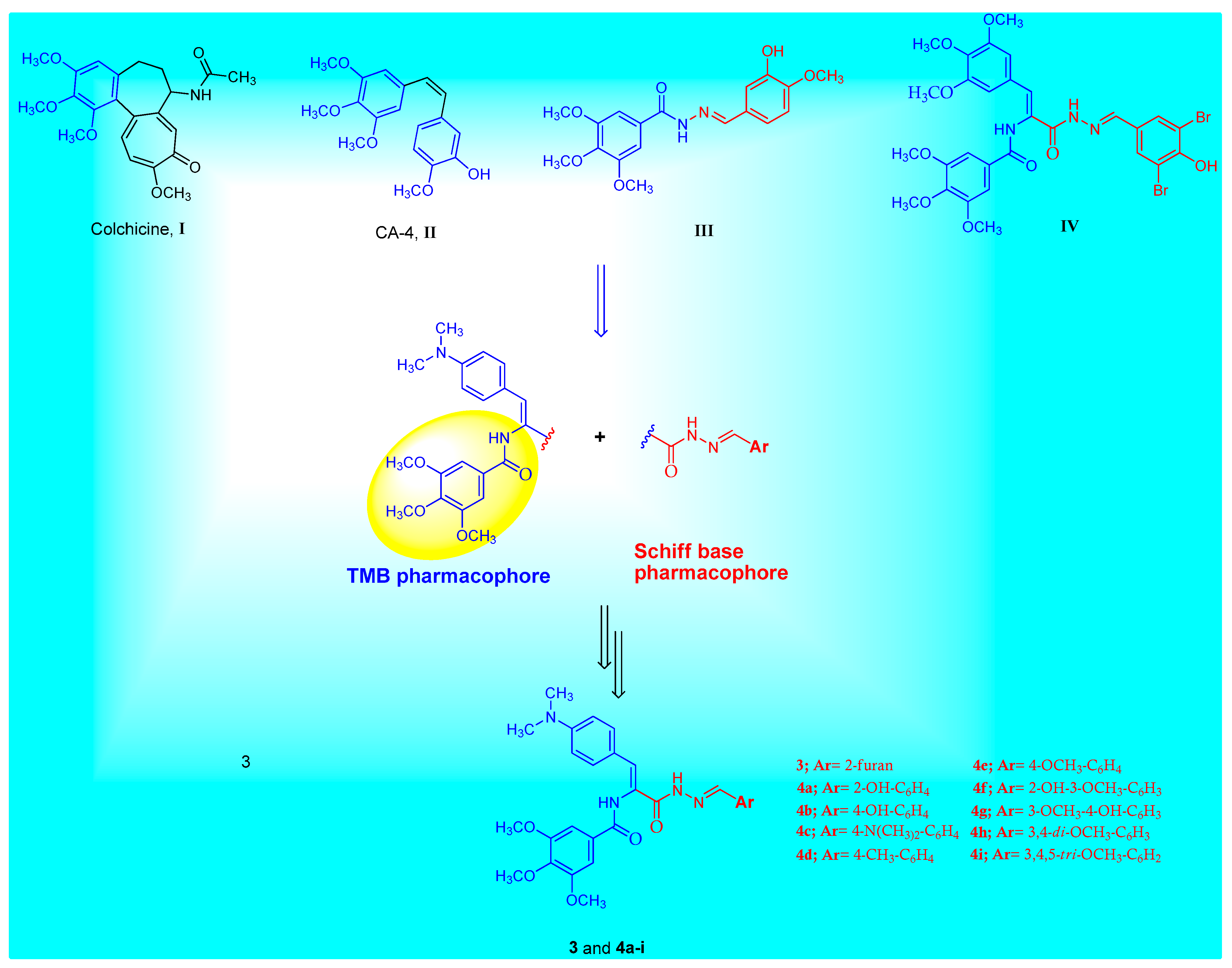
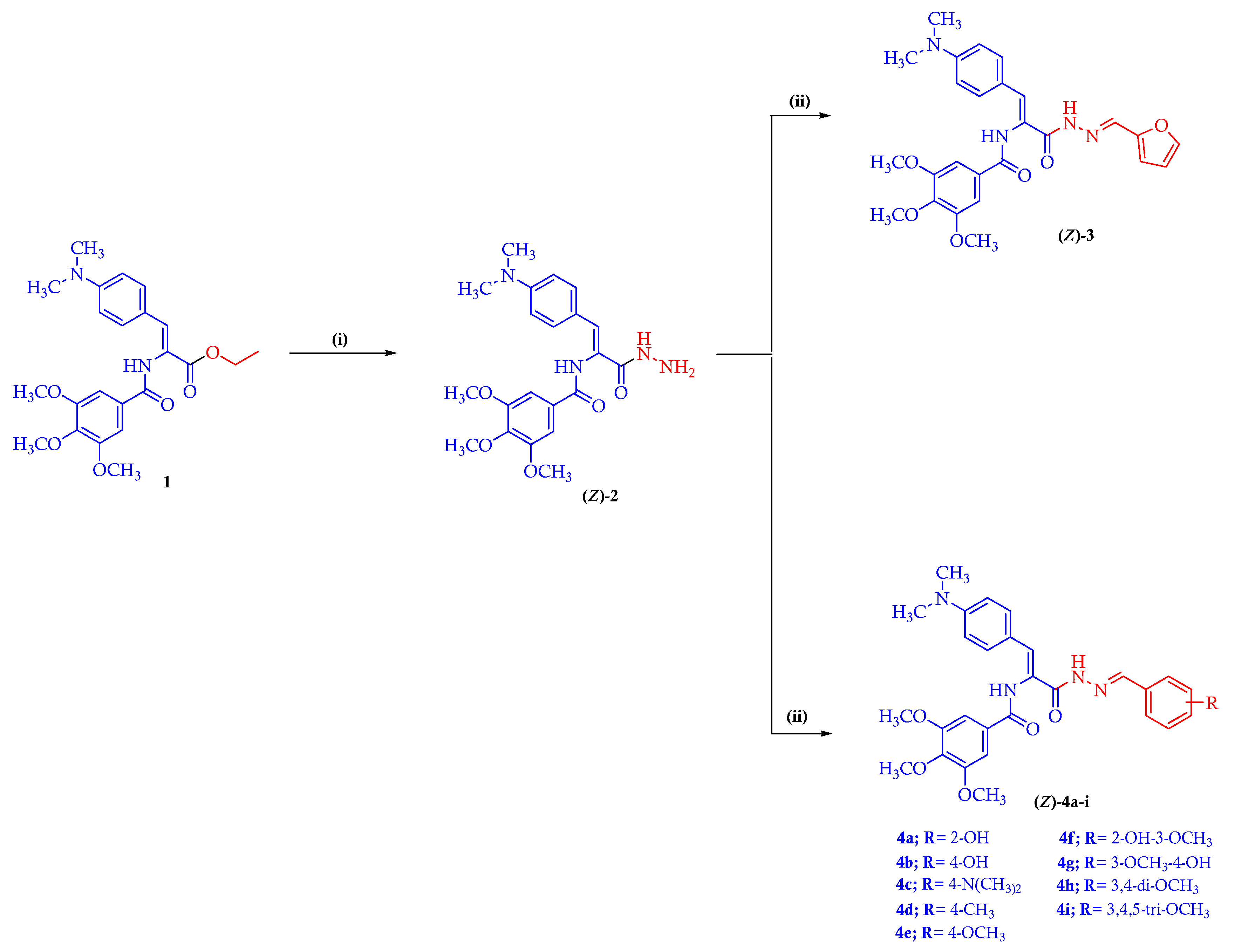
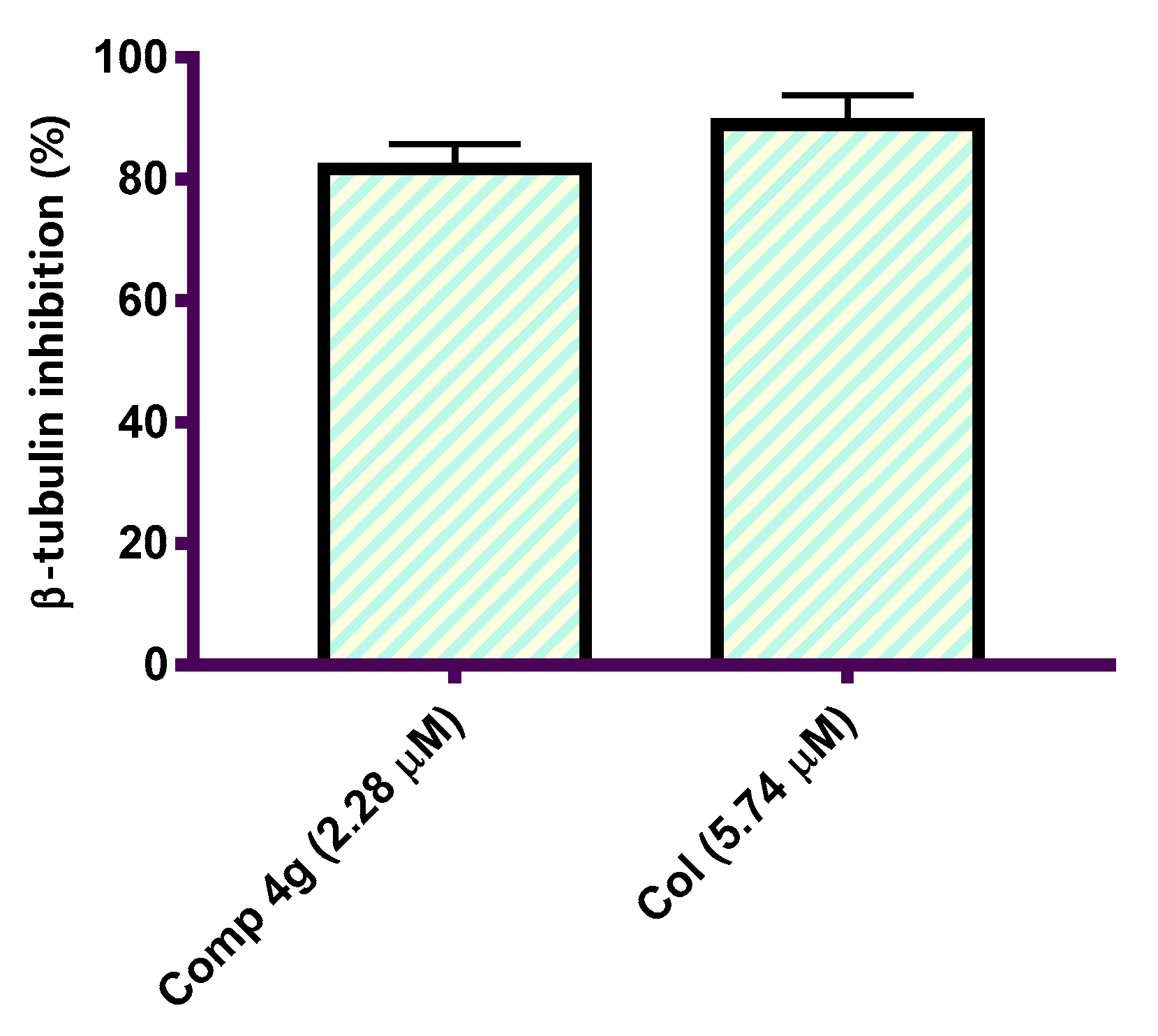

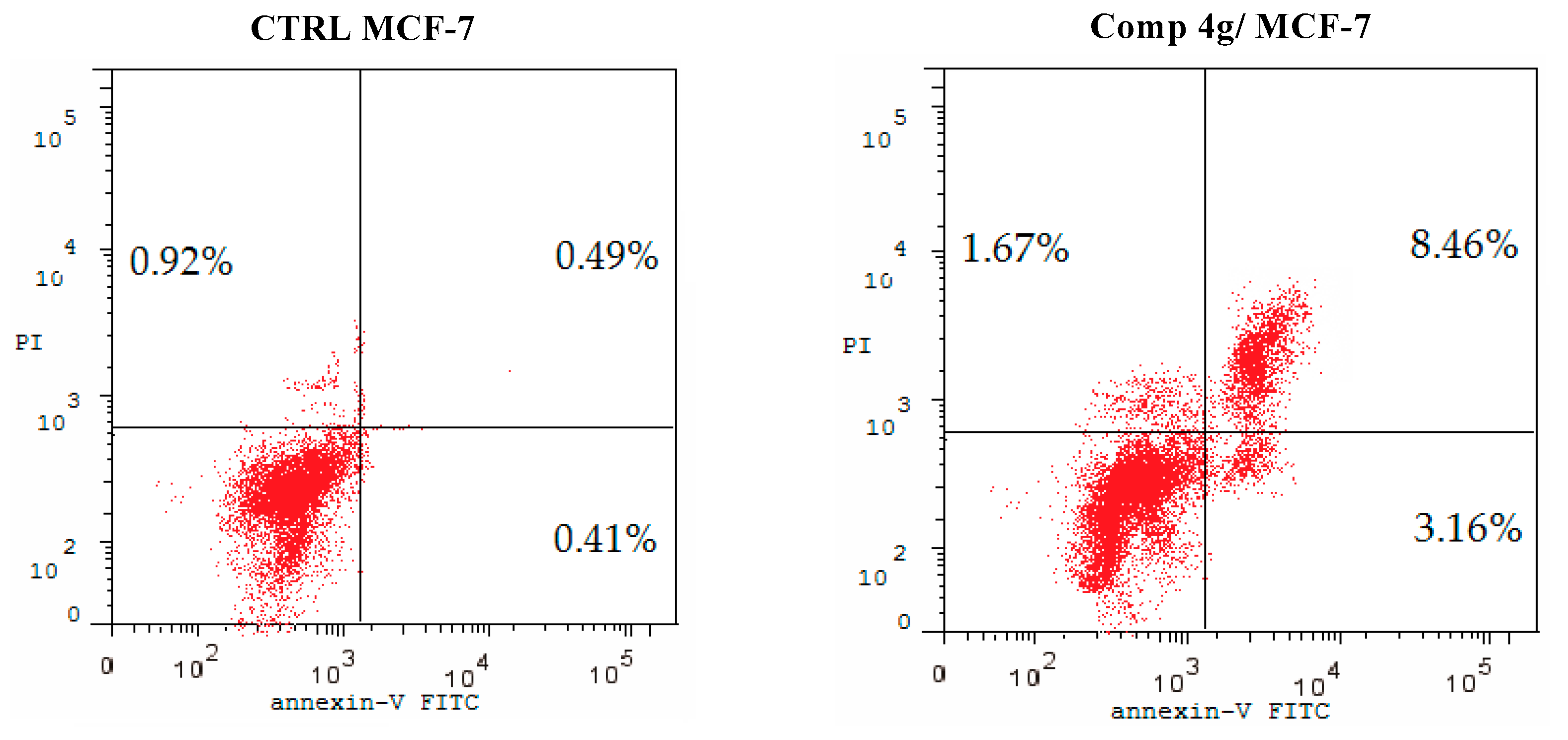
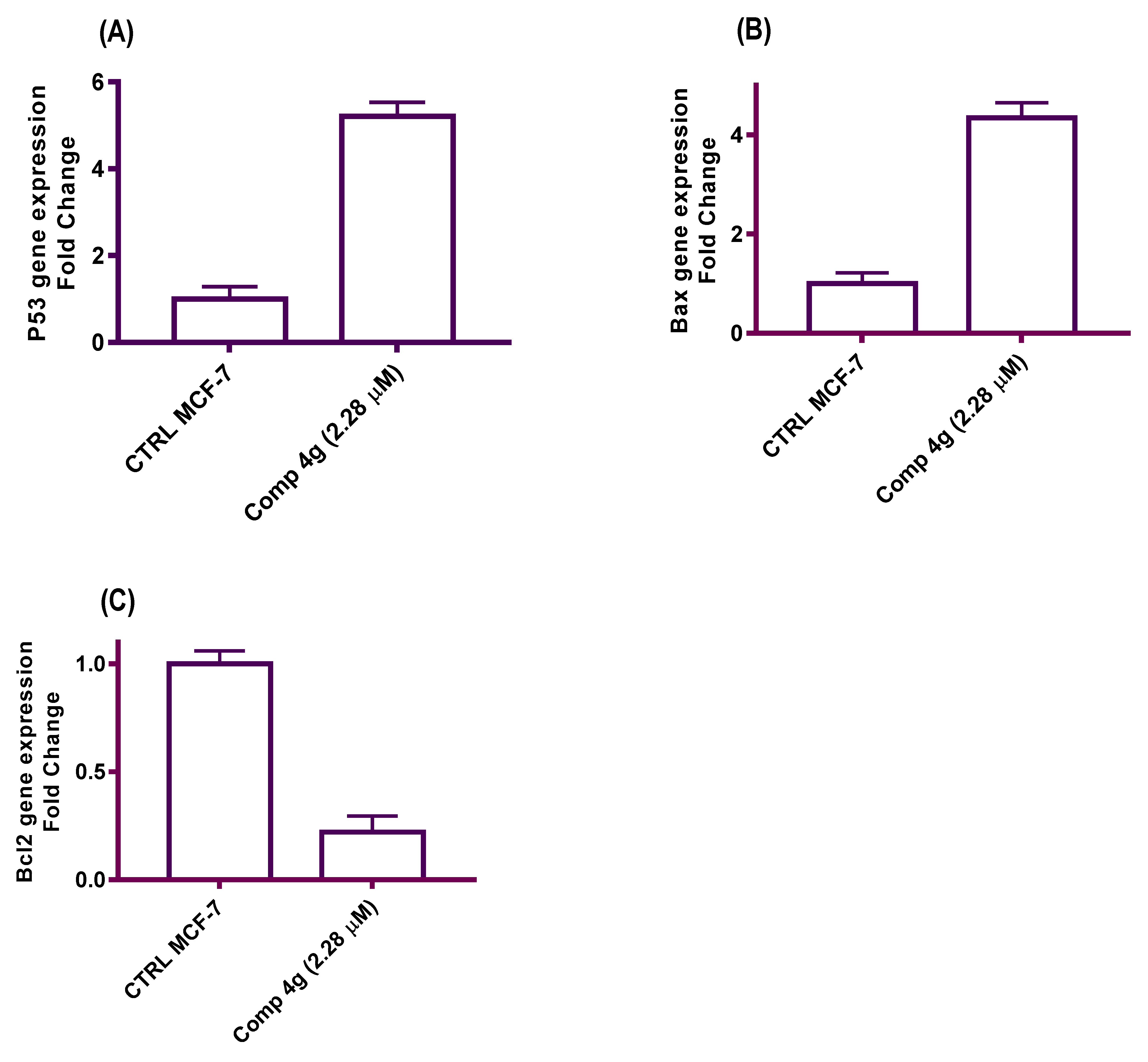

| Comp No. | IC50 Value (μM) | |
|---|---|---|
| MCF-7 | MCF-10A | |
| 3 | 12.10 ± 0.95 | NT |
| 4a | 6.20 ± 0.51 | NT |
| 4b | 4.74 ± 0.47 | NT |
| 4c | 18.64 ± 0.99 | NT |
| 4d | 13.69 ± 0.89 | NT |
| 4e | 24.02 ± 0.91 | NT |
| 4f | 4.01 ± 0.25 | NT |
| 4g | 2.28 ± 0.18 | 26.84 ± 0.32 |
| 4h | 9.37 ± 0.56 | NT |
| 4i | 102.09 ± 1.19 | NT |
| Col | 5.74 ± 0.21 | 31.15 ± 0.18 |
Disclaimer/Publisher’s Note: The statements, opinions and data contained in all publications are solely those of the individual author(s) and contributor(s) and not of MDPI and/or the editor(s). MDPI and/or the editor(s) disclaim responsibility for any injury to people or property resulting from any ideas, methods, instructions or products referred to in the content. |
© 2023 by the author. Licensee MDPI, Basel, Switzerland. This article is an open access article distributed under the terms and conditions of the Creative Commons Attribution (CC BY) license (https://creativecommons.org/licenses/by/4.0/).
Share and Cite
Alyamani, N.M. New Schiff Base–TMB Hybrids: Design, Synthesis and Antiproliferative Investigation as Potential Anticancer Agents. Symmetry 2023, 15, 609. https://doi.org/10.3390/sym15030609
Alyamani NM. New Schiff Base–TMB Hybrids: Design, Synthesis and Antiproliferative Investigation as Potential Anticancer Agents. Symmetry. 2023; 15(3):609. https://doi.org/10.3390/sym15030609
Chicago/Turabian StyleAlyamani, Najiah M. 2023. "New Schiff Base–TMB Hybrids: Design, Synthesis and Antiproliferative Investigation as Potential Anticancer Agents" Symmetry 15, no. 3: 609. https://doi.org/10.3390/sym15030609




